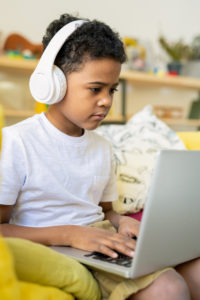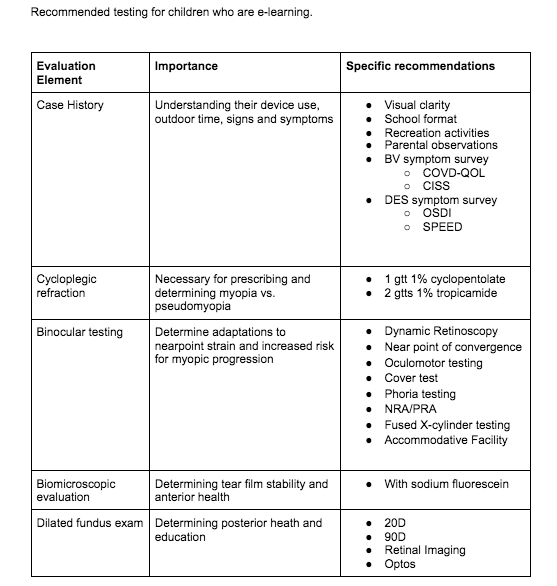November 1, 2020
By Nathan Bonilla-Warford, OD, FAAO, FCOVD, FIAOMC
 If your practice is anything like mine, you have seen an increase in patients coming to the office with complaints of visual discomfort, blurry vision and irritated eyes in the past few months. While patients of all ages are experiencing these problems, one group is notable: school-aged children in an online education program. This article will examine this trend, explore the visual issues these children may be at risk for, including myopia, and what actions can help these patients.
If your practice is anything like mine, you have seen an increase in patients coming to the office with complaints of visual discomfort, blurry vision and irritated eyes in the past few months. While patients of all ages are experiencing these problems, one group is notable: school-aged children in an online education program. This article will examine this trend, explore the visual issues these children may be at risk for, including myopia, and what actions can help these patients.
2020: A Year Like No Other
This year, family life has been turned upside down by COVID-19. Popular summer activities such as sports, concerts and camps have been limited or eliminated to reduce the coronavirus spread. Without these social opportunities, children are turning to virtual activities for social interaction with friends. To meet this demand, online games such as Among Us have surged in popularity.1
The back-to-school season is even more challenging. In my county nearly half of parents are planning to keep their kids home to pursue e-learning.2 E-learning requires that students maintain a similar school schedule, except that all of the classes are conducted via online platforms such as Zoom. This is a lot of screen time for these children.
Quantifying the Problem
While total screen time has increased, it is specifically the small digital screens that interest kids. They are much less likely to view a large TV or desktop monitor in favor of smartphones and tablets.3 This marked increase in small device use comes with a price.
Stephen Lipsky, MD, a pediatric ophthalmologist, says, “I really have seen a marked increase in kids suffering from eye strain because of increased screen time.”4 Pediatric ophthalmologist Samantha Roland, MD, educates parents that they may see their “child rolling their eyes and blinking excessively when they’ve been staring at the computer for too long.”5
Jobson’s ECP Coronavirus Survey, Wave 16, reports 71 percent of respondents are seeing patients with more visual issues due to screen time, 69 percent report this includes both children and adults, and 60 percent of respondents are changing their practice to put more emphasis on children’s care due to increased screen time.6
What to Look For
Dry eyes in kids: While dry eye used to be considered an adult problem, children can suffer symptoms, too, which can be related to screen time.7 One study found that reduction in digital device use was an effective treatment for these symptoms.8
Binocular vision dysfunction: Not only does near work contribute to visual symptoms due to binocular vision dysfunction such as esophoria or high exophoria,9 but also increased lag of accommodation has been associated with high myopia.10,11, 12
Myopia: It seems intuitive that more near work increases the risk of myopia, and there is evidence for this.13, 14 The link has not been demonstrated conclusively, although McCrann and coresearchers showed an association between myopia and smartphone data usage.15 What is widely documented is that the lack of outside time increases a child’s chance to become myopic.16 Children who are e-learning spend less time outdoors than children who attend classes at a traditional school.
Recommended Testing
All children who are e-learning should be evaluated thoroughly. See the chart below for specific suggestions.

Solutions
Both during and after the COVID-19 pandemic, children will need our help. Consider these recommendations for e-learning students:
Visual Hygiene – Parents and children must understand the importance of working distance (greater than 30 cm), visual breaks (20 seconds every 20 minutes) and outdoor time (at least 120 minutes per day.)
Ergonomics – Advise patients to use a workstation with a large enough screen appropriately designed to encourage good posture.
Glasses – Near point glasses can reduce fatigue and manage any binocular vision problems the child may have.
Myopia management – Many children who might not have been candidates for myopia management may now be or will be candidates soon.
Parental Education
Help parents understand that the potential visual problems from e-learning are both short-term and longer term. Fortunately, most parents are now aware that excessive screen time is not ideal for their child, although they do not understand precisely how or why. This is an opportunity for ECPs to educate patients about myopia and the short-term and long-term effects on ocular health.
There are many avenues for education:
- During the exam – I speak about this with parents and children during every exam, whether the child is myopic or not.
- In-office signage and screen
- Website information – We have created a special webpage at our practice to assist parents: brighteyestampa.com/e-learning-guide/
- Social media – Facebook, Instagram, posts on computer vision, dry eye and myopia, etc. can help drive the narrative.
- PR and news media exposure – Although it is a hectic news cycle, people recognize that e-learning is not ideal for children’s health, and vision is a component of that issue.
Conclusion
E-learning students have increased screen time and decreased outdoor time. Both factors can put children at risk for myopia. We will likely continue to see symptomatic patients and progression in myopia. We have a professional responsibility to educate parents and children and make appropriate recommendations.

Nathan Bonilla-Warford, OD, FAAO, FCOVD, FIAOMC, is the founder and owner of Bright Eyes Family Vision Care and Bright Eyes Kids located in Tampa, Florida.
References:
- Epstein, A, How an obscure 2018 computer game became a global phenomenon overnight, Quartz, October 1, 2020, https://qz.com/1911718/how-among-us-became-a-global-video-game-phenomenon/
- Davidson, L and Lanning, J, Survey Results Are In: Nearly Half of Hillsborough County Students Opt for eLearning, Bay News 9, JUL. 22, 2020, https://www.baynews9.com/fl/tampa/news/2020/07/22/nearly-half-of-hillsborough-county-students-opt-for-elearning
- Fischer, S, Axios, Kids’ daily screen time surges during coronavirus, March 31, 2020 https://www.axios.com/kids-screen-time-coronavirus-562073f6-0638-47f2-8ea3-4f8781d6b31b.https://www.axios.com/kids-screen-time-coronavirus-562073f6-0638-47f2-8ea3-4f8781d6b31b.htmlhtml
- Hutton, D, Ophthalmologists anticipate virtual learning will drive increase in eye strain, August 14, 2020, https://www.ophthalmologytimes.com/view/ophthalmologists-anticipate-virtual-learning-will-drive-increase-in-eye-strain
- Silcox, F, With Increased Virtual Learning, Pediatricians Warn of Eye Strain, August, 06, 2020 https://www.baynews9.com/fl/tampa/news/2020/08/06/with-increased-virtual-learning–pediatricians-warn-of-eye-strain-
- Jobson Research, Coronavirus ECP Study – Wave 15, https://www.reviewob.com/download/37676/
- Shirley, Z. Prevalence of dry eye symptoms and relationship to screen time in a New York City pediatric population. Invest. Ophthalmol. Vis. Sci. 2020;61(7):340. https://iovs.arvojournals.org/article.aspx?articleid=2766486
- Moon, J, et al. Smartphone use is a risk factor for pediatric dry eye disease according to region and age: a case control study. BMC Ophthalmol 16, 188 (2016). https://bmcophthalmol.biomedcentral.com/articles/10.1186/s12886-016-0364-4
- Kozeis N., Impact of computer use on children’s vision. Hippokratia. 2009;13(4):230-231.
- Gwiazda, J, et al, Accommodation, Accommodative Convergence, and Response AC/A Ratios Before and at the Onset of Myopia in Children, Optometry and Vision Science: April 2005 – Volume 82 – Issue 4 – p 273-278
- Berntsen, D, et al., Accommodative lag and juvenile-onset myopia progression in children wearing refractive correction. Vision Res. 2011;51(9):1039-1046.
- Brown B. Is esophoria a factor in slowing of myopia by progressive lenses? Optom Vis Sci. 2002 Oct;79(10):638-42.
- Ip JM, Role of near work in myopia: findings in a sample of Australian school children. Invest Ophthalmol Vis Sci. 2008 Jul;49(7):2903-10. doi: 10.1167/iovs.07-0804. PMID: 18579757.
- Holden, BA, Global Prevalence of Myopia and High Myopia and Temporal Trends from 2000 through 2050, Ophthalmology, VOLUME 123, ISSUE 5, P1036-1042,
- McCrann, S. (2020). Smartphone use as a possible risk factor for myopia. Clinical and Experimental Optometry.
- Xiong S, et al. Time spent in outdoor activities in relation to myopia prevention and control: a meta-analysis and systematic review. Acta Ophthalmol. 2017;95(6):551-566.













